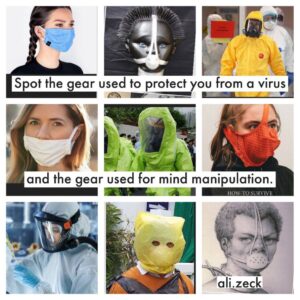
1. Surgeons have been using surgical masks since their introduction in 1897. It has for some years been customary for surgeons and nurses to wear surgical masks in the operating theatre and to change masks part of the way through any procedure lasting more than a few hours. The dangers associated with mask wearing were assessed by five doctors and published in the journal Neurocirugia in 2008.
Although it is customary for operating theatres to be fitted with air conditioning systems, the writers of the article, entitled, Preliminary Report on Surgical Mask induced Deoxygenation During Major Surgery, pointed out that it is known that heat and moisture are trapped beneath surgical masks and concluded that ‘it seems reasonable that some of the exhaled carbon dioxide may also be trapped beneath them, inducing a decrease in blood oxygenation’.
A total of 53 surgeons, of both sexes, all employed at university hospitals and aged between 24 and 54 years of age were tested. All were non-smokers and none had any chronic lung disease. The test involved pulse oximetry before and after the course of an operation. The study showed that the longer a mask was worn the greater the fall in blood oxygen levels. This may lead to the individual passing out and it may also affect natural immunity – thereby increasing the risk of infection. The masks used were disposable, sterile, one-way surgical paper masks. To eliminate the effect of dehydration over a several hour surgical operation, the surgeons were allowed after every hour to drink water through a straw.
The authors of the paper concluded that, ‘When the values for oxygen saturation of haemoglobin were compared, there were statistically significant differences only between preoperational and post operational values. As the duration of the operation increases, oxygen saturation of haemoglobin decreases significantly.’

2. This quote is taken from New England Journal of Medicine: ‘We know that wearing a mask outside health care facilities offers little, if any, protection from infection. Public health authorities define a significant exposure to covid-19 as face to face contact within six feet with a patient with symptomatic covid-19 that is sustained for at least a few minutes (and some say more than 10 minutes or even 20 minutes). The chance of catching covid-19 from a passing interaction in a public space is therefore minimal. In many cases the desire for widespread masking is a reflexive reaction to anxiety over the pandemic.’ The reference is: M.Klompas, C.Morris et al ‘Universal Masking in hospitals in the covid-19 era’ – New
England Journal of Medicine 2020

3. It is possible that wearing a mask for hours at a time could cause pulmonary fibrosis. In August 1988, the proceedings of the VIIth International Pneumoconioses Conference included details of three cases of pulmonary fibrosis, thought to be due to exposure to synthetic textile fibres. The first was a woman of 52 who had a dry cough with increasing difficulty in breathing. Changes were visible on an X-ray. The woman had been working in a textile shop for 15 years where her job was measuring and cutting cloth – mainly synthetic materials. The second patient was a woman of 66 who also had difficulty in breathing. The lungs of this patient also showed X-ray changes. She was also involved in cutting and measuring synthetic fabrics. A third woman, aged 47, had bilateral pulmonary fibrosis. Studies have shown that loose fibres are seen on all types of masks and may be inhaled causing serious lung damage.
4.People who cough and sneeze into their mask increase the risk of a build-up of fungi and bacteria – which can lead to dangerous chest infections.
5. In 2015, the British Medical Journal published a paper entitled, A Cluster Randomized Trial of Cloth Masks Compared with Medical Masks in Healthcare Workers. The paper was written by nine authors from the University of New South Wales, the University of Sydney, the National Institute of Hygiene and Epidemiology in Vietnam and the Beijing Centers for Disease Control and Prevention in China. The aim of the study was to compare the efficacy of cloth masks to medical masks in hospital health care workers. The study, which was extensive, concluded that the results caution against the use of cloth masks.

‘This is an important finding to inform occupational health and safety,’ concluded the authors. ‘Moisture retention, reuse of cloth masks and poor filtration may result in increased risk of infection.’ And the authors added: ‘…as a precautionary measure, cloth masks should not be recommended for health care workers, particularly in high risk situations, and guidelines need to be updated’.
For the remaining 95 facts, click here!
Source: Dr. Vernon Coleman
…let he who has ears…